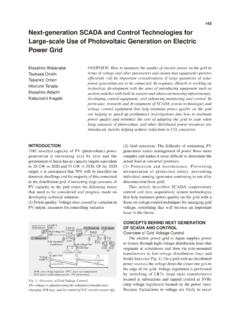Transcription of Tunable Diode Laser (TDL) based Hydrogen …
1 Tunable Diode Laser (TDL) based Hydrogen Chloride gas (HCl) continuous Emission monitoring System (CEMS) Development Challenges to Meet EPA s Draft Performance Specification Keith Crabbe Cemtek Environmental, Santa Ana, CA Gervase Mckay Unisearch Associates, Toronto, ON CAN Paul Tran Cemtek Environmental, Santa Ana, CA John T. Pisano and Thomas D. Durbin Department of Chemical and Environmental Engineering, Bourns College of Engineering, Center for Environmental Research and Technology (CE-CERT) University of California, Riverside, CA ABSTRACT New regulations and emissions limits are requiring the measurement and reporting of Hydrogen Chloride gas (HCl) levels. Both the Utility Boiler and Portland Cement Maximum Achievable Control Technology (MACT) rules for the first time require industry wide measurements for regulatory reporting requirements.
2 Cemtek Environmental and Unisearch Associates have been involved in the HCl monitoring Performance Specification stakeholder s group information exchange with the Environmental Protection Agency (EPA) for development of the new Draft Performance Specification for HCl CEMS. Cemtek has participated in a demonstration test at a North American cement manufacturing facility which investigated the performance of Tunable Diode Laser based HCl CEMS as outlined in the draft performance specification. This paper will present the demonstration field setup, the tests conducted including comparison with reference method, and obstacles and lessons learned in completing the tests along with additional laboratory trial results.
3 INTRODUCTION The United Sates Environmental Protection agency has put in place new rule regulating the emission of Hydrogen Chloride gas (HCl) from Stationary sources. These rules include the amendments to the NESHAP for Portland cement plants and to the NSPS for Portland cement plants and Coal fired Electric utility plants under the Mercury and Air Toxics Rule (MATS). These rules finalize standards that originated with Clean Air Act of 1990. At the time this study began the EPA regulations at 40 CFR63, Subpart LLL which require installation, certification, operation and ongoing quality assurance of HCl CEMS to demonstrate continuous compliance with a 3 ppm HCl corrected to 7% O2, dry basis emission limit on a 30-day rolling average by not later than September 2013.
4 Holcim Inc. developed, planned and executed a field evaluation project of four HCl CEMS at its St. Genevieve plant during the summer and fall of 2012. The general objectives of the study were to determine if contemporary HCl continuous emission monitoring systems (CEMS) have the capability, accuracy, precision and reliability. Cemtek Environmental using a Unisearch Associates HCl TDL analyzer was invited to participate in this evaluation. CEMTEK s interest was to perform and practice some of the tests in the EPA draft performance specification 18. At the same time we were providing comments and feed back to the EPA team developing the PS as a stakeholder. The results of this effort are presented here along with some observations and issues in the conclusion of the report.
5 (1) EXPERIMENTAL The study was conducted at the St. Genevieve plant under the direction of Glen Rosenhamer, Corporate Environmental Manager. Michelle Ferguson, Plant Environmental Manager, Aaron Dwyer (Electrical Superintendent), Rodney Miller (Instrumentation Specialist) provided extensive support for the project over many months. Jim Peeler, Emission monitoring Inc. (EMI) provided consulting assistance during the entire project, participated in the field test, and prepared this report. Phil Kauppi, Prism Analytical Technologies, Inc. performed the FTIR testing for the stratification test, the Method 321 tests for the RATAs, and analyzed numerous compressed gas cylinders.
6 (1) The Holcim St. Genevieve (GV) plant is a contemporary preheater precalciner kiln system which began operation during 2009. The kiln system has two inline raw mills and operating conditions include: (a) both raw mills operating, (b) one raw mill operating, and (c) no raw mills operating. These operating conditions affect the associated effluent HCl concentrations, the concentrations of other effluent components including NH3, as well as the effluent gas temperatures. HCl effluent concentrations varied over a range of 0-20 ppm, wet basis. Effluent gas temperatures also vary with operating condition and were expected to be approximately 205 F (two mills on), 255 F (one mill on) and 320 F (no mills operating).
7 (1) INSTRUMENTATION Tunable Diode Lasers (TDL s) have special properties based upon small crystals (about mm2) made of a mixture of elements such as gallium, arsenic, antimony and phosphorus. The proper selection and proportion of these elements the crystal can be made to emit at wavelengths where the target gas, which is HCl in this application, absorbs radiation of a particular energy. Changing either the temperature or current through the Laser permits the wavelength to be tuned over the selected absorption feature of the target molecule. When an electric current is passed through these crystals they emit very pure Laser light in the near-infrared spectral region.
8 The temperature of the Laser , which is stabilized with a thermoelectric cooler, will roughly establish the wavelength near the target gas absorption feature. The Laser current is then simultaneously modulated in the kilohertz region so that phase sensitive detection techniques may be used to improve sensitivity. One advantage of the TDL technology is that the presence of the measured component in the gas stream can be used as a reference point for the Laser itself. This function is called line locking and consists of the absorption peak of the HCl being used to keep the Laser at the desired frequency. However, in the absence of the measurement component, during bypass or scheduled shutdowns, the Laser can drift, and be outside calibration when the measurement component returns.
9 To avoid drift, this TDL is supplied with a sealed internal reference cell, which contains a known amount of the gas to be measured. The use of the reference cells allows for not only line locking of the analyzer, but also the ability to continuously monitor the instrument s calibration. We conducted some testes using this cell to report calibration drift test results in the results section of this study. The calculations which determine the actual gas concentration use Beer-Lambert Law. I = Ioe- cl (1) Where: I = Intensity of light after absorption by target molecule Io = Intensity of light with no absorption by target molecule = Absorption cross section (species specific) c = Concentration (number density) of target molecule l = Path length Beer s Law is based on the relative absorption of light at wavelengths which are not absorbed versus light which is absorbed by the molecule of interest.
10 The intensities I and Io are determined by scanning the wavelength using the characteristic tunability of Diode lasers, which allows the emission wavelength to be adjusted over a span of a few nanometers. This is sufficient to span certain absorption features in molecules such as ammonia, carbon monoxide, methane, and others. The only important variable is the fraction of light which is absorbed at the middle of the scan (return power, I) vs. the extreme ends of the scan (initial power, Io). The Laser is scanned at a frequency of approximately 4 kHz, or every 250 micro seconds ( s) so that variations in Io due to external factors (such as changing dust levels) will be very small.









